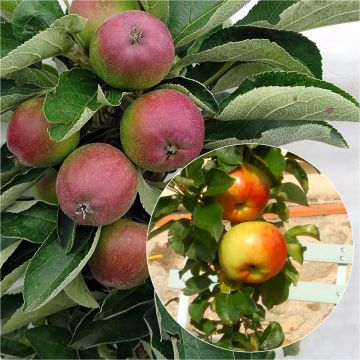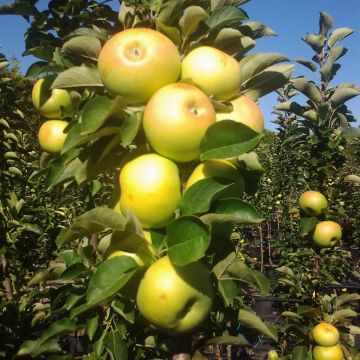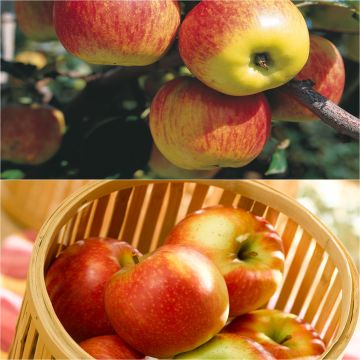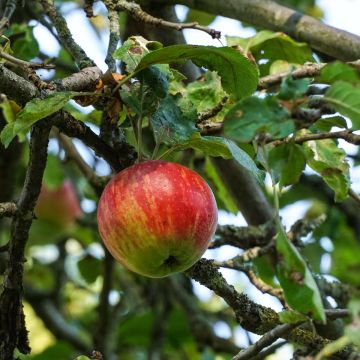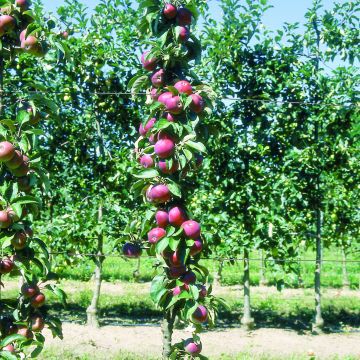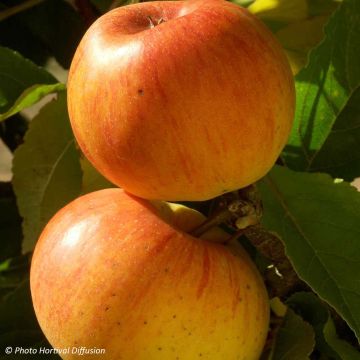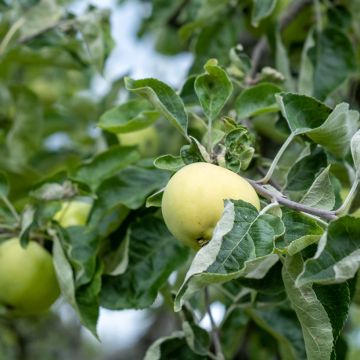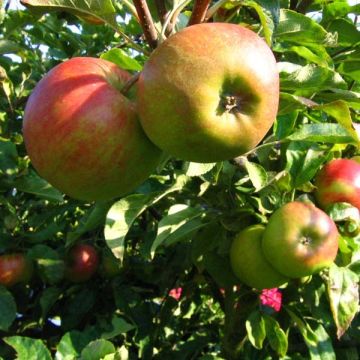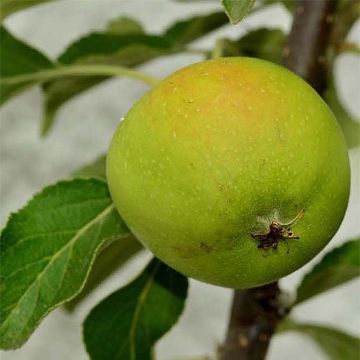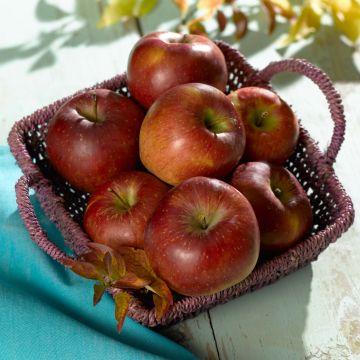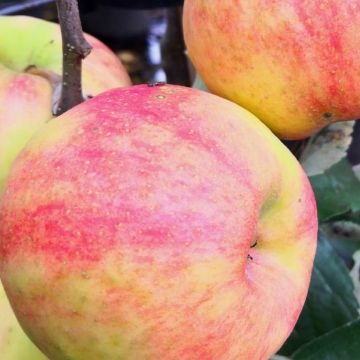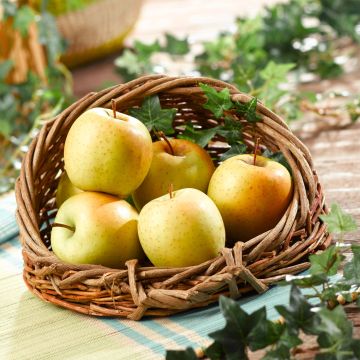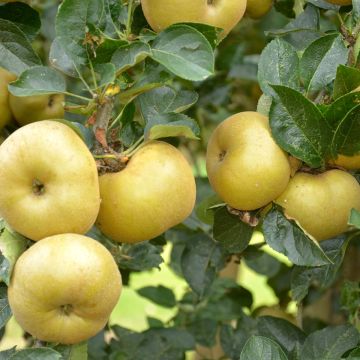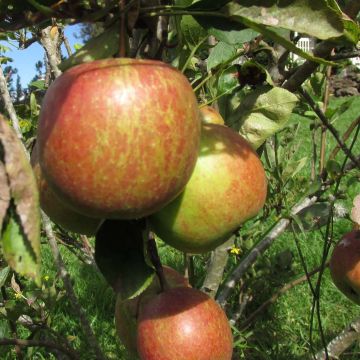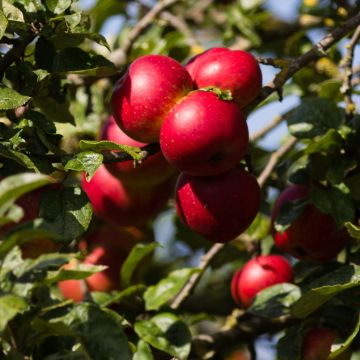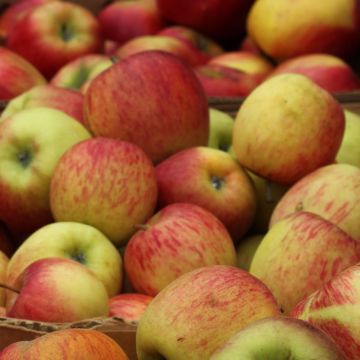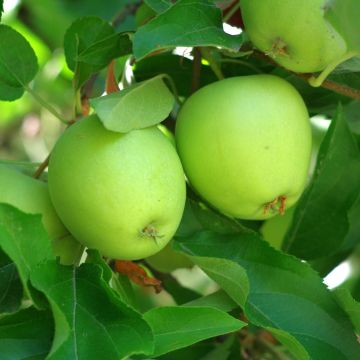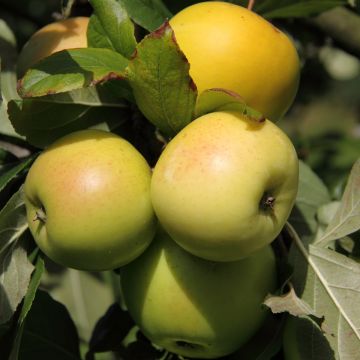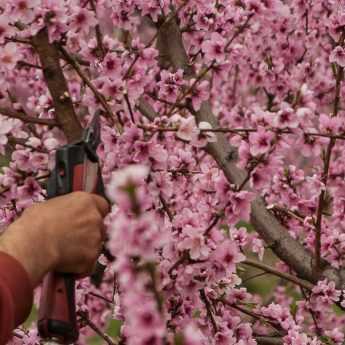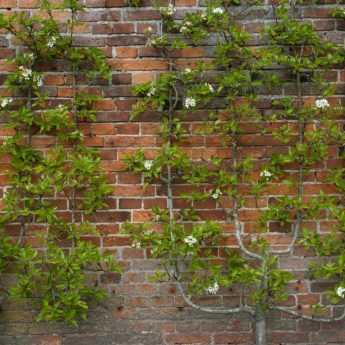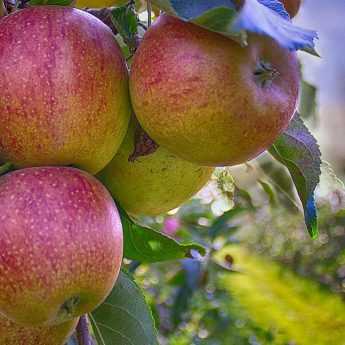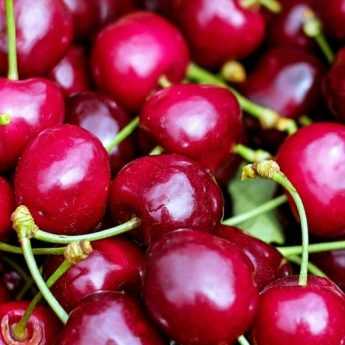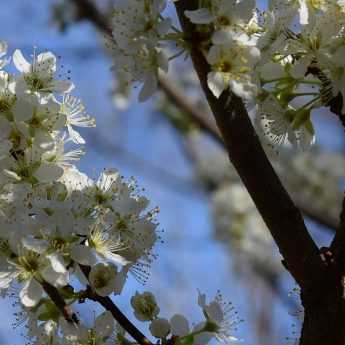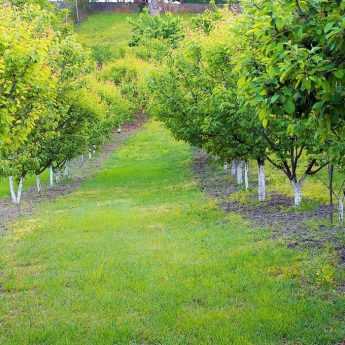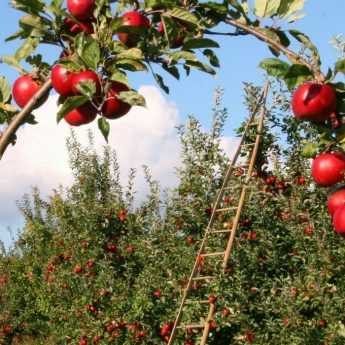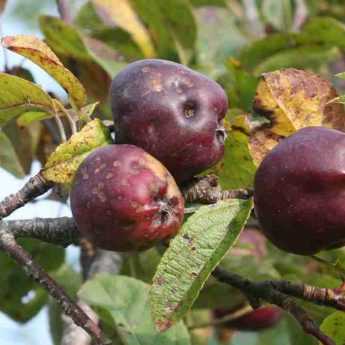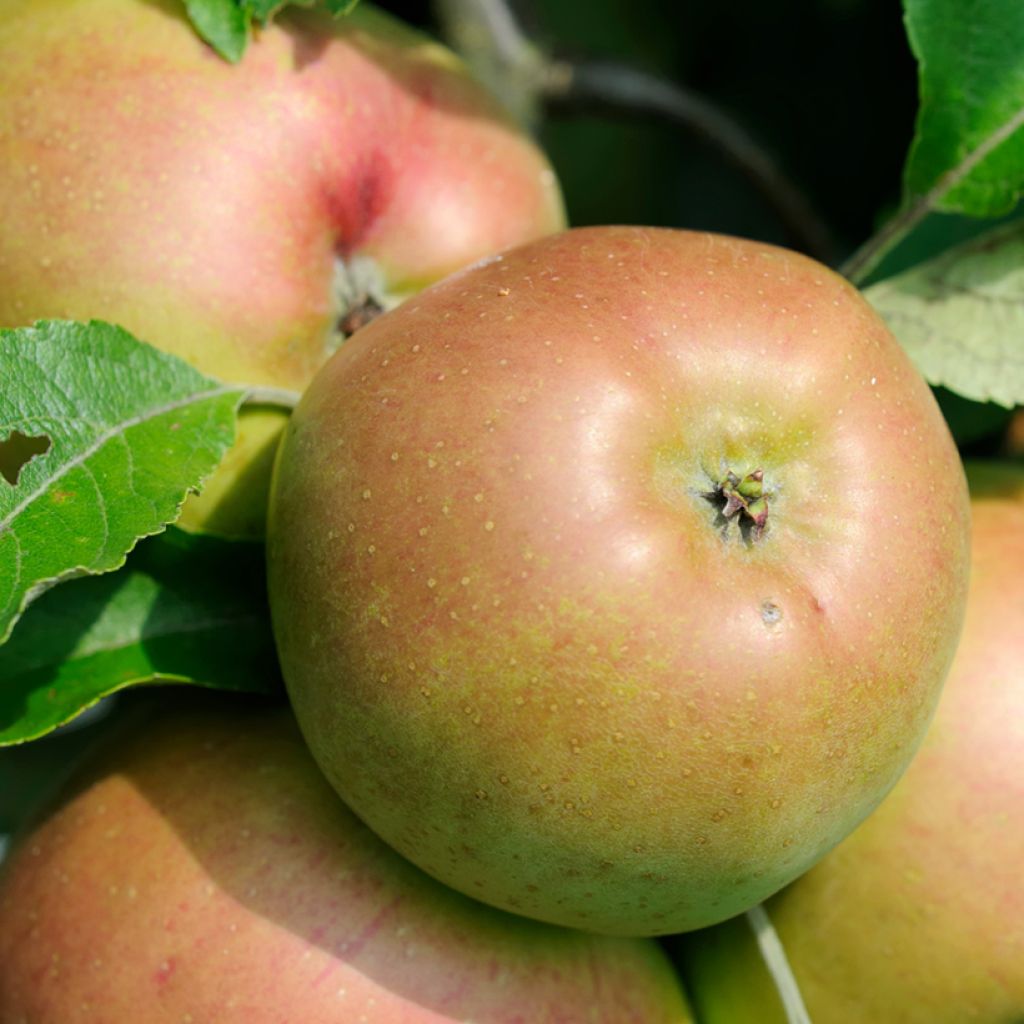

Malus domestica Pepina Parkera - Pommier domestique, Pommier commun
Malus domestica Pepina Parkera - Pommier domestique, Pommier commun
Malus domestica Pepina Parkera
Pommier domestique, Pommier commun
Why not try an alternative variety in stock?
View all →This plant carries a 6 months recovery warranty
More information
We guarantee the quality of our plants for a full growing cycle, and will replace at our expense any plant that fails to recover under normal climatic and planting conditions.
Description
The 'Pepina Parker' Apple Tree originates from England, although it is mainly cultivated on the continent. This heritage variety is easily recognisable by the russet colour of its fruits. Their greenish flesh, firm and crunchy, is both slightly tart and aromatic, as well as juicy. It is a delicious apple to enjoy fresh, and equally suitable for preparing desserts and drinks. The moderately sized tree forms a rounded crown and is well-suited to small gardens. Easy to grow, as it is not very susceptible to diseases, it requires pollination by another variety to produce a harvest.
The Apple Tree, like most of our fruit trees (Cherry Tree, Peach Tree, Raspberry Bush...) belongs to the vast Rosaceae family. The genus Malus includes fruiting species, such as the Common Apple Tree (Malus domestica, synonymous with Malus communis or Malus pumila), and ornamental ones, the "Flowering Crabapples" (like the charming Malus 'Royal Beauty'). Cultivated since ancient times (before the Roman era), the Apple Tree is a fruit tree native to the forests of Central Asia, with around 20,000 varieties known today.
The Malus 'Pepina Parker' originated from a random seedling selected by the English Captain William Parker in the 18th century, hence its name. It is also known by numerous synonyms across Europe: 'Parker Peppin', 'Pépin gris de Parker', 'Sanct-Nicolas Reinette', 'Jadrnac Parkeruv', etc. The tree forms a medium-sized crown, rounded to slightly flattened, with a decent density of branches. Its growth is moderately vigorous, reaching approximately 4m in height and 3.5m in spread. Under English climatic conditions, full flowering occurs in early May, or as early as April in milder regions. Small, single, pale pink-white flowers bloom for two to three weeks. Though lightly or not at all scented, they are nonetheless appreciated by bees. Being non-self-fertile, the flowers must be pollinated by pollen from other varieties, so another tree must be planted nearby. Various varieties can serve this role, such as ‘Baumana Reneta’ (‘Baumann’s Reinette’), ‘Reinette Ananas’, ‘Cox Orange’, or ‘Golden Reneta’. The yellow-green skin is covered with heavy russeting, giving it a very distinctive russet hue and slight roughness. Held on the tree by a short, thick stalk, the fruits are spherical, flattened at both ends, slightly more convex on one side, and lightly ribbed. Their diameter is quite modest, around 6cm, with a height of 5.5cm. However, they are abundant, and the harvest is quite respectable. Their greenish-white flesh is firm and crunchy, moderately aromatic, tangy, and juicy. It is very pleasant to eat raw and also makes excellent juice and even cider. Ripening in October, these apples can, under good conditions, be stored until the following March.
‘Pepina Parker’ is an interesting apple variety for enthusiasts, as it is not very prone to common diseases like scab and powdery mildew. Its moderate hardiness suits lowland areas, and its size allows it to be grown in most gardens, even those with limited space. Plant it alongside other fruit trees with staggered ripening periods to enjoy fruit over several months. A Redcurrant Bush ‘Ribest Babette’ will delight you with its tangy red berries as early as June, while a Perpetual Raspberry Bush extends the pleasure until September. The Cherry Tree ‘Bigarreau Burlat’ will even allow you to start enjoying your own fruit as early as May, while the wide range of Pear Trees provides late summer and autumn varieties to complement your Apple Tree.
Plant habit
Fruit
Flowering
Foliage
Botanical data
Malus
domestica
Pepina Parkera
Rosaceae
Pommier domestique, Pommier commun
Malus domestica Parker's Apple, Pépin de Parker, Parkers Pepping
Cultivar or hybrid
Other Apple trees
View all →Planting and care
Choose a sunny spot for your 'Pepina Parkera' Apple Tree. The soil can be slightly chalky or acidic, but not excessively so. Dig a wide planting hole at least three times the volume of the root ball. Simultaneously add organic matter (compost, potting soil...) and a base fertiliser like ground horn. Do not bury the graft junction. Stake if necessary. For apple trees planted in isolation and exposed to wind, it may be beneficial to stake them using a guy-wire system: plant 3 stakes in a triangle 50 cm around the trunk, join them together with pieces of wood. Protect the bark with a piece of rubber for example and attach the stakes to the trunk with wires. Water generously, even in winter, even if it rains. Fruit trees should ideally be planted between October and March, outside of frost periods. Plants supplied in containers can be planted all year round except during periods of extreme heat or frost.
In winter, you can add a small spadeful of wood ash rich in potash at the base of the tree, lightly incorporating it into the soil surface, which will improve fruiting. The Apple Tree can be susceptible to various diseases and pests. To limit risks, space trees sufficiently, plant mixed-species hedges, nest boxes or insect shelters to attract beneficial insects. In short: prioritise diversity. The main diseases of the Apple Tree are scab (brown spots on the leaves), brown rot (withering of flowers and rotting of fruit on the tree) and powdery mildew (white felting on the leaves). For these three cases, preventive action is preferable by spraying a horsetail decoction; as a last resort and during severe attacks, as a curative measure, you can apply a treatment based on a Bordeaux mixture. Fortunately, 'Pepina Parkera' is not very susceptible to scab and powdery mildew, nor to fire blight for which there is no cure.
As for pests, the codling moth (or fruit worm), is a small caterpillarfrom a moth egg, which digs tunnels within the fruit. To remedy this, it is preferable to act preventively by putting up nest boxes to encourage tits and bats to roost. In case of an aphid attack, spray a solution based on black soap.
For good storage of fruit after the harvest in October, it is advisable to place the apples with its peduncles facing downwards, in crates or trays. Choose a preferably completely dark, dry and cool, but frost-free place.
Planting period
Intended location
Care
Planting & care advice
This item has not been reviewed yet - be the first to leave a review about it.
Haven't found what you were looking for?
Hardiness is the lowest winter temperature a plant can endure without suffering serious damage or even dying. However, hardiness is affected by location (a sheltered area, such as a patio), protection (winter cover) and soil type (hardiness is improved by well-drained soil).

Photo Sharing Terms & Conditions
In order to encourage gardeners to interact and share their experiences, Promesse de fleurs offers various media enabling content to be uploaded onto its Site - in particular via the ‘Photo sharing’ module.
The User agrees to refrain from:
- Posting any content that is illegal, prejudicial, insulting, racist, inciteful to hatred, revisionist, contrary to public decency, that infringes on privacy or on the privacy rights of third parties, in particular the publicity rights of persons and goods, intellectual property rights, or the right to privacy.
- Submitting content on behalf of a third party;
- Impersonate the identity of a third party and/or publish any personal information about a third party;
In general, the User undertakes to refrain from any unethical behaviour.
All Content (in particular text, comments, files, images, photos, videos, creative works, etc.), which may be subject to property or intellectual property rights, image or other private rights, shall remain the property of the User, subject to the limited rights granted by the terms of the licence granted by Promesse de fleurs as stated below. Users are at liberty to publish or not to publish such Content on the Site, notably via the ‘Photo Sharing’ facility, and accept that this Content shall be made public and freely accessible, notably on the Internet.
Users further acknowledge, undertake to have ,and guarantee that they hold all necessary rights and permissions to publish such material on the Site, in particular with regard to the legislation in force pertaining to any privacy, property, intellectual property, image, or contractual rights, or rights of any other nature. By publishing such Content on the Site, Users acknowledge accepting full liability as publishers of the Content within the meaning of the law, and grant Promesse de fleurs, free of charge, an inclusive, worldwide licence for the said Content for the entire duration of its publication, including all reproduction, representation, up/downloading, displaying, performing, transmission, and storage rights.
Users also grant permission for their name to be linked to the Content and accept that this link may not always be made available.
By engaging in posting material, Users consent to their Content becoming automatically accessible on the Internet, in particular on other sites and/or blogs and/or web pages of the Promesse de fleurs site, including in particular social pages and the Promesse de fleurs catalogue.
Users may secure the removal of entrusted content free of charge by issuing a simple request via our contact form.
The flowering period indicated on our website applies to countries and regions located in USDA zone 8 (France, the United Kingdom, Ireland, the Netherlands, etc.)
It will vary according to where you live:
- In zones 9 to 10 (Italy, Spain, Greece, etc.), flowering will occur about 2 to 4 weeks earlier.
- In zones 6 to 7 (Germany, Poland, Slovenia, and lower mountainous regions), flowering will be delayed by 2 to 3 weeks.
- In zone 5 (Central Europe, Scandinavia), blooming will be delayed by 3 to 5 weeks.
In temperate climates, pruning of spring-flowering shrubs (forsythia, spireas, etc.) should be done just after flowering.
Pruning of summer-flowering shrubs (Indian Lilac, Perovskia, etc.) can be done in winter or spring.
In cold regions as well as with frost-sensitive plants, avoid pruning too early when severe frosts may still occur.
The planting period indicated on our website applies to countries and regions located in USDA zone 8 (France, United Kingdom, Ireland, Netherlands).
It will vary according to where you live:
- In Mediterranean zones (Marseille, Madrid, Milan, etc.), autumn and winter are the best planting periods.
- In continental zones (Strasbourg, Munich, Vienna, etc.), delay planting by 2 to 3 weeks in spring and bring it forward by 2 to 4 weeks in autumn.
- In mountainous regions (the Alps, Pyrenees, Carpathians, etc.), it is best to plant in late spring (May-June) or late summer (August-September).
The harvesting period indicated on our website applies to countries and regions in USDA zone 8 (France, England, Ireland, the Netherlands).
In colder areas (Scandinavia, Poland, Austria...) fruit and vegetable harvests are likely to be delayed by 3-4 weeks.
In warmer areas (Italy, Spain, Greece, etc.), harvesting will probably take place earlier, depending on weather conditions.
The sowing periods indicated on our website apply to countries and regions within USDA Zone 8 (France, UK, Ireland, Netherlands).
In colder areas (Scandinavia, Poland, Austria...), delay any outdoor sowing by 3-4 weeks, or sow under glass.
In warmer climes (Italy, Spain, Greece, etc.), bring outdoor sowing forward by a few weeks.


































